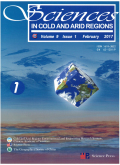- 钛学术文献服务平台 \
- 学术期刊 \
- 基础科学期刊 \
- 天文学、地球科学期刊 \
- 寒旱区科学(英文版)期刊 \
Processes of runoff in seasonally-frozen ground about a forested catchment of semiarid mountains
Processes of runoff in seasonally-frozen ground about a forested catchment of semiarid mountains
基本信息来源于合作网站,原文需代理用户跳转至来源网站获取
摘要:
Climate warming increases the variability in runoff of semiarid mountains where seasonally-frozen ground is widely dis-tributed. However, what is not well understood are the processes of runoff, hydrological drivers, and freeze-thaw cycles in seasonally-frozen ground in semiarid mountains. To understand how freeze-thaw cycles affect runoff processes in season-ally-frozen ground, we monitored hydrological processes in a typical headwater catchment with seasonally-frozen ground in Qilian Mountain, China, from 2002 to 2017. We analyzed the responses of runoff to temperature, precipitation, and seasonally-frozen ground to quantify process characteristics and driving factors. The results show that annual runoff was 88.5 mm accounting for 25.6%of rainfall, mainly concentrated in May to October, with baseflow of 36.44 mm. Peak runoff occurred in June, August, and September, i.e., accounting for spring and summer floods. Runoff during the spring flood was produced by a mix of rainfall, melting snow, and melting seasonally-frozen ground, and had a significant corre-lation with air temperature. Runoff was mainly due to precipitation accumulation during the summer flood. Air tempera-ture, average soil temperature at 0?50 cm depth, and frozen soil depth variable explained 59.60%of the variation of runoff in the thawing period, while precipitation variable explained 21.9%. Thawing-period runoff and soil temperature had a>0.6 correlation coefficient (P<0.05). In the rainfall-period, runoff was also affected by temperature, soil moisture, and precipi-tation, which explained 33.6%, 34.1%and 18.1%, respectively. Our results show that increasing temperature and precipita-tion will have an irreversible impact on the hydrological regime in mountainous basins where seasonally-frozen ground is widely distributed.

推荐文章
Zinc isotope fractionation under vaporization processes and in aqueous solutions
Evaporation process
Zinc isotope
Kinetic isotope fractionation
Equilibrium fractionation
Zinc species in solution
Geochemistry and petrology of superpure quartzites from East Sayan Mountains, Russia
High-purity quartz
Superquartzite
Gravitational sliding
Dynamic metamorphism
Recrystallization
Dated deposition couplets link catchment erosion flux with storm discharge on the Chinese Loess Plat
Landslide-dammed reservoir on the CLP
Deposition couplet
XRF core scanning
137Cs activity
Erosion flux
Hydrogeochemical processes and multivariate analysis for groundwater quality in the arid Maadher reg
Groundwater quality
Hydrogeochemical processes
Multivariate analysis
Salinity
Mio-Plio
Quaternary aquifer
内容分析
关键词云
关键词热度
相关文献总数
(/次)
(/年)
文献信息
| 篇名 | Processes of runoff in seasonally-frozen ground about a forested catchment of semiarid mountains | ||
| 来源期刊 | 寒旱区科学(英文版) | 学科 | |
| 关键词 | |||
| 年,卷(期) | 2020,(5) | 所属期刊栏目 | Articles |
| 研究方向 | 页码范围 | 272-283 | |
| 页数 | 12页 | 分类号 | |
| 字数 | 语种 | 英文 | |
| DOI | |||
五维指标
引文网络
引文网络
二级参考文献 (137)
共引文献 (55)
参考文献 (40)
节点文献
引证文献 (0)
同被引文献 (0)
二级引证文献 (0)
1924(1)
- 参考文献(0)
- 二级参考文献(1)
1973(1)
- 参考文献(0)
- 二级参考文献(1)
1978(1)
- 参考文献(0)
- 二级参考文献(1)
1981(1)
- 参考文献(0)
- 二级参考文献(1)
1982(3)
- 参考文献(0)
- 二级参考文献(3)
1983(2)
- 参考文献(1)
- 二级参考文献(1)
1985(1)
- 参考文献(0)
- 二级参考文献(1)
1986(1)
- 参考文献(0)
- 二级参考文献(1)
1988(2)
- 参考文献(0)
- 二级参考文献(2)
1990(1)
- 参考文献(1)
- 二级参考文献(0)
1992(1)
- 参考文献(0)
- 二级参考文献(1)
1995(2)
- 参考文献(0)
- 二级参考文献(2)
1996(3)
- 参考文献(0)
- 二级参考文献(3)
1997(1)
- 参考文献(1)
- 二级参考文献(0)
1998(1)
- 参考文献(1)
- 二级参考文献(0)
1999(5)
- 参考文献(1)
- 二级参考文献(4)
2000(3)
- 参考文献(0)
- 二级参考文献(3)
2001(3)
- 参考文献(1)
- 二级参考文献(2)
2002(4)
- 参考文献(0)
- 二级参考文献(4)
2003(3)
- 参考文献(1)
- 二级参考文献(2)
2004(7)
- 参考文献(2)
- 二级参考文献(5)
2005(7)
- 参考文献(1)
- 二级参考文献(6)
2006(9)
- 参考文献(1)
- 二级参考文献(8)
2007(6)
- 参考文献(1)
- 二级参考文献(5)
2008(4)
- 参考文献(1)
- 二级参考文献(3)
2009(10)
- 参考文献(1)
- 二级参考文献(9)
2010(12)
- 参考文献(2)
- 二级参考文献(10)
2011(10)
- 参考文献(0)
- 二级参考文献(10)
2012(11)
- 参考文献(2)
- 二级参考文献(9)
2013(16)
- 参考文献(6)
- 二级参考文献(10)
2014(14)
- 参考文献(2)
- 二级参考文献(12)
2015(11)
- 参考文献(1)
- 二级参考文献(10)
2016(9)
- 参考文献(4)
- 二级参考文献(5)
2017(7)
- 参考文献(5)
- 二级参考文献(2)
2018(4)
- 参考文献(4)
- 二级参考文献(0)
2020(0)
- 参考文献(0)
- 二级参考文献(0)
- 引证文献(0)
- 二级引证文献(0)
引文网络交叉学科
相关学者/机构
期刊影响力
寒旱区科学(英文版)
主办单位:
中国科学院寒区旱区环境与工程研究所
科学出版社有限责任公司
出版周期:
双月刊
ISSN:
1674-3822
CN:
62-1201/P
开本:
出版地:
甘肃省兰州市东岗西路320号
邮发代号:
创刊时间:
语种:
eng
出版文献量(篇)
870
总下载数(次)
0
总被引数(次)
1072
期刊文献
相关文献
推荐文献
- 期刊分类
- 期刊(年)
- 期刊(期)
- 期刊推荐
力学
化学
地球物理学
地质学
基础科学综合
大学学报
天文学
天文学、地球科学
数学
气象学
海洋学
物理学
生物学
生物科学
自然地理学和测绘学
自然科学总论
自然科学理论与方法
资源科学
非线性科学与系统科学
寒旱区科学(英文版)2022
寒旱区科学(英文版)2021
寒旱区科学(英文版)2020
寒旱区科学(英文版)2019
寒旱区科学(英文版)2018
寒旱区科学(英文版)2017
寒旱区科学(英文版)2016
寒旱区科学(英文版)2015
寒旱区科学(英文版)2014
寒旱区科学(英文版)2013
寒旱区科学(英文版)2012
寒旱区科学(英文版)2011
寒旱区科学(英文版)2010
寒旱区科学(英文版)2009
寒旱区科学(英文版)2008
寒旱区科学(英文版)2020年第6期
寒旱区科学(英文版)2020年第5期
寒旱区科学(英文版)2020年第4期
寒旱区科学(英文版)2020年第3期
寒旱区科学(英文版)2020年第2期
寒旱区科学(英文版)2020年第1期

 免费查重
免费查重










